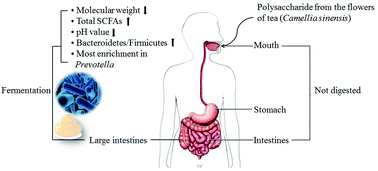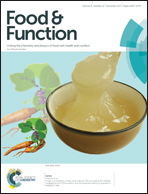Digestion under saliva, simulated gastric and small intestinal conditions and fermentation in vitro of polysaccharides from the flowers of Camellia sinensis induced by human gut microbiota†
Abstract
In the present study, digestion under saliva, simulated gastric and small intestinal conditions and fermentation in vitro of polysaccharides from the flowers of Camellia sinensis (TFPS) by human gut microbiota were investigated. The results indicated that human saliva and simulated gastric and intestinal juices had no effect on TFPS, while TFPS could be utilized by human fecal microbiota, which was proved from the decreased molecular weight and lower content of total or reducing sugars after fermentation under anaerobic conditions. It was found that pH in the fermentation system decreased, and the production of short-chain fatty acids was significantly enhanced. Furthermore, in vitro fermentation of TFPS altered the composition of gut microbiota, specifically in elevating the ratio of Bacteroidetes to Firmicutes and enriching Prevotella. The present results suggest that TFPS has the potential to be developed as functional foods to modify gut microbiota.



 Please wait while we load your content...
Please wait while we load your content...